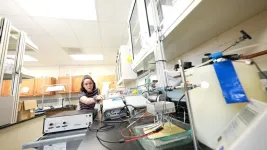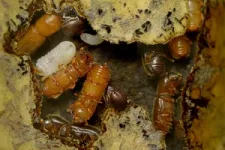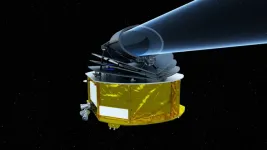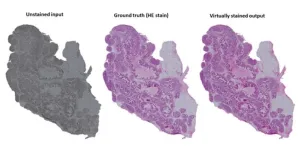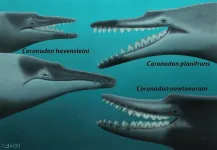(Press-News.org) Associate Professor Jonathan Boreyko leads a team at Virginia Tech that has built a strong portfolio of work with ice and water, exploring the possibilities for de-icing planes, building novel water harvesting devices, and creating snow globes out of bubbles. This familiarity with water has given the team a strong sense of its behavior in different states, leading to a new project that shows how ice quenches heat in comparison to water. The findings were published in Chem on April 14.
Mojtaba Edalatpour and master’s student Camryn Colón carried out this project. They investigated methods of quenching heat from metal, a critical step in applications such as metallurgy and firefighting. Both instances require speed. Metallurgists need to rapidly drop the temperature of a forged piece to achieve specific material properties, while firefighters work to stop destruction of property as quickly as possible. Quenching with water is only effective beneath a critical temperature — any higher and the water levitates on its own vapor and can no longer boil the heat away.
WATCH VIDEO: https://video.vt.edu/id/1_yk54e4pp
Boreyko’s team wanted to see if using ice, rather than water, could bypass the levitation issue to enable the quenching of ultra-hot surfaces.
Measuring, heating, and measuring again
To conduct this research, Edalatpour and Colón heated an aluminum stage and measured the cooling rate of water versus ice. To ensure a direct comparison, they released the same amount of water and ice onto the surface after it was heated to a desired temperature.
When the initial surface temperature of the stage was between 100 and 300 degrees Celsius, both the water and the ice successfully quenched the surface below 100 C. The ice, however, achieved that result in half the time. At higher initial temperatures — 300 to 500 C — only quenching with ice was successful. Heat transfer with ice was more than 100 times more effective than with liquid water at these high temperatures.
What was the difference? The properties of water prevent it from hitting the sweet spot for removing heat.
That sweet spot is boiling, because the steam escaping in bubbles most efficiently carries the heat away. Because water easily levitates on its vapor at high temperatures, it becomes insulated from the surface and the boiling never occurs. Ice behaves differently. When dropped onto a hot surface, ice absorbs much of the heat as it melts. This reduces the amount of heat available for producing vapor bubbles, preventing the levitation problem. In other words, the meltwater boils at a slower pace compared to pure water, thus helping to maintain boiling at high temperatures.
Boreyko compared the unusual liquid behavior with worker productivity.
“Think about a workaholic who is always focusing on their job,” he said. “They start off hyper-productive but quickly burn out and become ineffective. It turns out that water is the same way when exposed to ultra-high temperature surfaces: It is so focused and productive at boiling water into vapor that it experiences ‘burnout,’ which is the scientific term for levitation and the catastrophic failure in cooling that results. So ice is like the slow and steady tortoise that wins in the long run. It doesn’t make vapor bubbles very well, but this allows it to keep boiling and avoid levitation when things get heated.”
The frozen path continues
The group’s hypothesis of using ice for quenching followed its recent discovery that ice does not levitate and lose its boiling capability until 550 C, compared to 150 C for water. Based on those findings, Boreyko’s team began several new projects applying its principles. This heat transfer is the first outgrowth to be published.
Colón’s follow-up work includes measuring the cooling performance of ice when the surface is fixed at a constant temperature rather than being allowed to cool down.
“When you have a constant temperature, you can measure the steady-state heat flux, which would allow us to directly compare the heat transfer of ice versus state-of-the-art boilers,” said Colón.
The team is also brainstorming how to implement a practical ice quenching system.
“It remains to be seen exactly how to implement three-phase heat transfer for real life applications, but we’re excited to figure it out over the next several years,” said Boreyko. “It might involve making spray nozzles that are able to eject ice particles instead of water, or perhaps it will look more like releasing a pre-formed block of ice onto an overheated surface. There’s a lot more to figure out before this becomes an on-the-shelf technology.”
END
Finding the dream team to beat the heat
Large, superheated objects can be difficult to cool. In Jonathan Boreyko’s lab, the team has found that ice, water, and vapor could be the ideal combination.
2023-04-14
ELSE PRESS RELEASES FROM THIS DATE:
Analysis of health and prescription data suggests chronic health conditions in U.S. incarcerated people may be severely undertreated
2023-04-14
Chronic conditions such as type 2 diabetes, asthma, HIV infection, and mental illness may be greatly undertreated in the U.S. jail and prison population, suggests a new study from researchers at the Johns Hopkins Bloomberg School of Public Health.
For their analysis, the researchers used national health survey data covering 2018 to 2020 to estimate rates of chronic conditions among recently incarcerated people, and a commercial prescription database to estimate the distribution of medication treatments to the jail and prison population. Their analysis suggests ...
In-person vs virtual education and community COVID-19 case incidence following school re-openings
2023-04-14
About The Study: In a study of matched pairs of counties that reopened with in-person versus virtual instruction at the secondary school level in the 2020 to 2021 academic year, counties with in-person school instructional models early in the COVID-19 pandemic experienced increases in county-level COVID-19 incidence at six and eight weeks after in-person reopening, compared with counties with virtual instructional models.
Authors: Meredith Matone, Dr.P.H., of Children’s Hospital of Philadelphia, is the corresponding author.
To access the embargoed study: Visit our For The ...
Black representation in the primary care physician workforce and its association with population life expectancy
2023-04-14
About The Study: The findings of this study of survival outcomes for 1,618 U.S. counties suggest that greater representation of Black primary care physicians (PCPs) in the PCP workforce is associated with improved survival-related outcomes for Black individuals, although there was a dearth of U.S. counties with at least one Black PCP during each study time point. Investments to build a more representative PCP workforce nationally may be important for improving population health.
Authors: John E. Snyder, M.D., M.S., M.P.H., and Rachel D. Upton, Ph.D., of the U.S. Department of Health and Human Services in Rockville, Maryland, are the corresponding ...
Racial, ethnic differences in barriers faced by medical college admission test examinees
2023-04-14
About The Study: In this study of 81,755 Medical College Admission Test examinees, American Indian or Alaska Native, Black, and Hispanic students reported lower parental educational levels, greater educational and financial barriers, and greater discouragement from pre-health advisers than white students. These barriers may deter groups underrepresented in medicine from applying to and matriculating at medical school.
Authors: Jessica Faiz, M.D., M.S.H.P.M., of the Veterans Affairs Greater Los Angeles Healthcare System and UCLA in Los Angeles, is the corresponding ...
Calling AI experts! Join the hunt for exoplanets
2023-04-14
Artificial Intelligence (AI) experts have been challenged to help a new space mission to investigate Earth’s place in the universe.
The Ariel Data Challenge 2023, which launches on 14 April, is inviting AI and machine learning experts from industry and academia to help astronomers understand planets outside our solar system, known as exoplanets.
Dr Ingo Waldmann, Associate Professor in Astrophysics, UCL (University College London) and Ariel Data Challenge lead said:
“AI has revolutionised many fields of science and industry in the past years. The field of exoplanets has fully arrived in the era of big-data and cutting edge AI is needed to break ...
Estonian researchers developed a method for instant energy-performance label
2023-04-14
The researchers of the FinEst Centre for Smart Cities of Tallinn University of Technology (Estonia, Europe) developed the DigiAudit platform to monitor and analyse energy use and indoor climate indicators of buildings and large real estate portfolios in real time. Thinnect, an Estonian IoT start-up company, will help sell the solution and market it worldwide.
We can only reach zero-emission buildings when we have reliable data
The European Union has set a target for all buildings to be zero-emission, or near-zero energy, by 2050. However, there is no reliable data on the energy consumption of many buildings, so it is not possible to monitor the condition ...
Researchers developed an AI-based method to replace chemical staining of tissue
2023-04-14
Researchers from the University of Eastern Finland, the University of Turku, and Tampere University have developed an artificial intelligence-based method for virtual staining of histopathological tissue samples as a part of the Nordic ABCAP consortium. Chemical staining has been the cornerstone of studying histopathology for more than a century and is widely applied in, for example, cancer diagnostics.
“Chemical staining makes the morphology of the almost transparent, low-contrast tissue sections visible. Without it, analysing tissue morphology is almost impossible for human vision. Chemical staining is irreversible, and in most ...
Rescuing corneal cells from death with the help of mitochondria
2023-04-14
Québec City, April 14, 2023 - Fuchs' endothelial corneal dystrophy, a degenerative eye disease, causes progressive vision loss that can induce blindness. It is the leading cause of corneal transplantation, but the scarcity of grafts hinders its treatment. A research team from Université Laval and Université de Montréal has identified a way to slow the disease and even avoid transplantation if diagnosed at an early stage.
In people with the disease, the endothelial cells at the back of the cornea die more quickly than in healthy people. "Everyone loses them at a slow rate, slow enough to make it to the end of our lives ...
New specimens and species of the Oligocene toothed baleen whale Coronodon from South Carolina and the origin of Neoceti
2023-04-14
A new study published in the journal PeerJ by Robert W. Boessenecker (CofC), Brian L. Beatty (NYIT), and Jonathan H. Geisler (NYIT) reports a wealth of new fossils of the early toothed baleen whale Coronodon from Oligocene (23-30 million years old) rock layers near Charleston, South Carolina. These include five new skulls, representing two new species: Coronodon planifrons and Coronodon newtonorum, and young juveniles of Coronodon havensteini – first named from a single skull by this team in 2017. Coronodon is one of the most primitive members ...
New family of wheel-like metallic clusters exhibit unique properties
2023-04-14
While the wheel does not need to be reinvented, there are benefits to the development of new nano-wheels, according to a multi-institute research team based in China. The group fabricated a novel family of metallic compounds, each of which exhibit unique properties desirable for next-generation technologies, such as advanced sensors.
Their findings were made available online on March 12 in Polyoxometalates.
“Polymetallic complexes are of great interest not only for their appealing molecular structure but also ...
LAST 30 PRESS RELEASES:
School meals could unlock major gains for human and planetary health
Menopause hormone therapy does not appear to impact dementia risk
Signature patterns of brain activity may help predict recovery from traumatic brain injury
Dresden study uncovers new key mechanism in cancer cells
New species are now being discovered faster than ever before, study suggests
Cannabis-based products show limited short-term benefit for chronic pain, with increased risk of adverse effects
Cannabis products with more THC slightly reduce pain but cause more side effects
Clearing the brain of aging cells could aid epilepsy and reduce seizures
Brain injuries linked with potential risk of suicide, new study finds
New technique lights up where drugs go in the body, cell by cell
New study finds movement of fishing fleets can reveal shifts in marine ecosystems
Embargoed: New evidence points to potential treatment for vascular dementia
Study uncovers disrupted brain balance in alcohol dependence
Working in groups can help Republicans and Democrats agree on controversial content moderation online
Structural findings reveal how distinct GPCR ligands create different levels of activation
Anything-goes “anyons” may be at the root of surprising quantum experiments
UC review: Maximizing workplace opportunity for veterans
From generation to complex control: Metasurfaces make perfect vortex beams "within reach"
Thin-film lithium niobate-based detector: recent advances and perspectives
Exploring why some people may tend to persistently make bad choices
How cells balance their protein levels
Nirsevimab vs RSVpreF vaccine for RSV–related hospitalization in newborns
Effectiveness and impact of maternal RSV immunization and nirsevimab on medically attended RSV in US children
AI gives scientists a boost, but at the cost of too many mediocre papers
Next-generation vision model maps tree growth at sub-meter precision
Genes aren’t destiny for inherited blindness, study shows
MIT study: High-fat diets make liver cells more likely to become cancerous
Exposure to multiple fine particulate matter components and incident depression in the US Medicare population
Risk of burdensome health care spending over time in the US
Nirsevimab against hospitalizations and emergency department visits for lower respiratory tract infection in infants
[Press-News.org] Finding the dream team to beat the heatLarge, superheated objects can be difficult to cool. In Jonathan Boreyko’s lab, the team has found that ice, water, and vapor could be the ideal combination.
